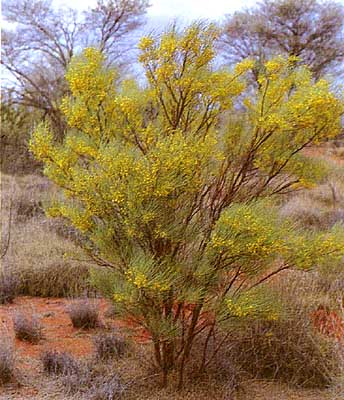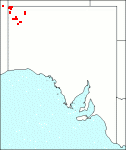Family: Fabaceae
Acacia pachyacra

Citation:
J. H. Maiden & W. F. Blakely, J.R. Soc. W. Aust. 13:21 t.14 (1927).
Derivation: pachys (Gr.)—thick; akros '(Gr.)--apex.
Synonymy: Not Applicable Common name: None
Description:
Erect, bushy or slender, glabrous shrubs 1-2 m high, branching into a number of ascending stems at ground level; branchlets and stems smooth reddish-brown, slightly pruinose, almost terete.
Phyllodes linear, almost terete or obtusely quadrangular with a prominent vein at each angle, 9-13 cm long, c. 1 mm broad, erect, brittle, dull-green, apex gland bearing below the small recurved thickened mucro, a second brown depressed gland situated at the base of phyllode just above the wrinkled pulvinus.
Inflorescences in axillary racemes shorter than phyllodes, usually consisting of 5-10 pedunculate heads; flower-heads rather small globular, bright yellow, c. 20-25-flowered; peduncles slender, glabrous, 4-5 cm long; flowers 5-merous.
Legumes oblong, 4-6 cm long, 7-8 mm broad, flat but raised over the seeds, chartaceous, light brown but shiny due to a resinous covering; margins vein-like, slightly constricted. Seeds in legume, almost orbicular, blackish; funicle thin, short, slightly twisted, without an aril.
|
|
Distribution:
|
A minor occurrence in the far north-west of the North-Western region in the Tomkinson Range and the Birksgate Range. In hummock grassland, low open woodland associated with Acacia aneura and Triodia basedowii. Soils; neutral red earths. Rainfall ca. 200 min. Also W.Aust. and N.T.
S.Aust.: NW.
|
Flowering time: August — October.
|

SA Distribution Map based
on current data relating to
specimens held in the
State Herbarium of South Australia
|
Biology:
No text
Related taxa:
Acacia murrayana (sp. 43) is similar in habit, flower and legume characters, but differs in having flat, linear-oblong to linear-lanceolate phyllodes with a small gland at the apex.
Cultivation:
Not known in cultivation, but would make an attractive ornamental or low shelter species in inland areas on sandy soils.
Author:
Not yet available
Source:

|

